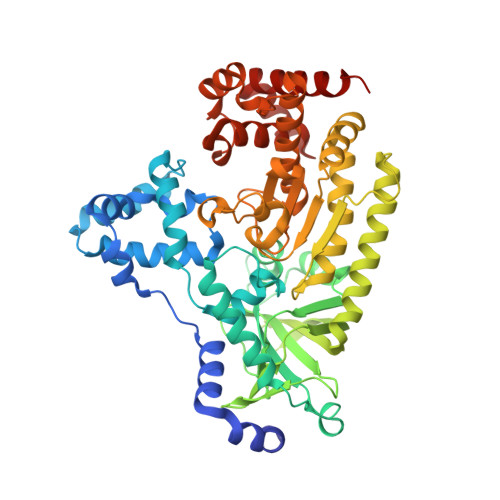Anthrax toxin lethal factor domain 3 is highly mobile and responsive to ligand binding.
Maize, K.M., Kurbanov, E.K., De La Mora-Rey, T., Geders, T.W., Hwang, D.J., Walters, M.A., Johnson, R.L., Amin, E.A., Finzel, B.C.(2014) Acta Crystallogr D Biol Crystallogr 70: 2813-2822
- PubMed: 25372673
- DOI: https://doi.org/10.1107/S1399004714018161
- Primary Citation of Related Structures:
4PKQ, 4PKR, 4PKS, 4PKT, 4PKU, 4PKV, 4PKW - PubMed Abstract:
The secreted anthrax toxin consists of three components: the protective antigen (PA), edema factor (EF) and lethal factor (LF). LF, a zinc metalloproteinase, compromises the host immune system primarily by targeting mitogen-activated protein kinase kinases in macrophages. Peptide substrates and small-molecule inhibitors bind LF in the space between domains 3 and 4 of the hydrolase. Domain 3 is attached on a hinge to domain 2 via residues Ile300 and Pro385, and can move through an angular arc of greater than 35° in response to the binding of different ligands. Here, multiple LF structures including five new complexes with co-crystallized inhibitors are compared and three frequently populated LF conformational states termed `bioactive', `open' and `tight' are identified. The bioactive position is observed with large substrate peptides and leaves all peptide-recognition subsites open and accessible. The tight state is seen in unliganded and small-molecule complex structures. In this state, domain 3 is clamped over certain substrate subsites, blocking access. The open position appears to be an intermediate state between these extremes and is observed owing to steric constraints imposed by specific bound ligands. The tight conformation may be the lowest-energy conformation among the reported structures, as it is the position observed with no bound ligand, while the open and bioactive conformations are likely to be ligand-induced.
Organizational Affiliation:
Department of Medicinal Chemistry and Minnesota Supercomputing Institute, University of Minnesota, 8-101 Weaver-Densford Hall, 308 Harvard Street SE, Minneapolis, MN 55455, USA.

















